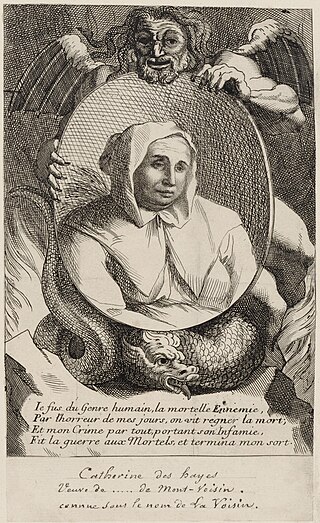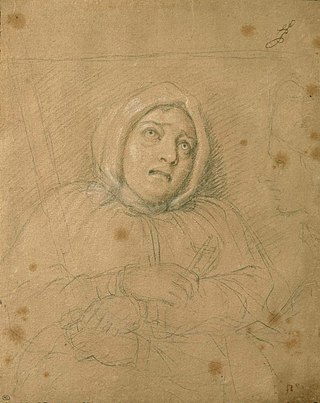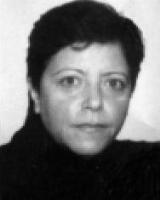
1659 (MDCLIX) was a common year starting on Wednesday of the Gregorian calendar and a common year starting on Saturday of the Julian calendar, the 1659th year of the Common Era (CE) and Anno Domini (AD) designations, the 659th year of the 2nd millennium, the 59th year of the 17th century, and the 10th and last year of the 1650s decade. As of the start of 1659, the Gregorian calendar was 10 days ahead of the Julian calendar, which remained in localized use until 1923.

Catherine Monvoisin, or Montvoisin, née Deshayes, known as "La Voisin", was a French fortune teller, commissioned poisoner, and professional provider of alleged sorcery. She was the head of a network of fortune tellers in Paris providing poison, aphrodisiacs, abortion, purported magical services and the arranging of black masses, with clients among the aristocracy and became the central figure in the famous affaire des poisons. Her purported organization of commissioned black magic and poison murder was suspected to have killed 1,000 people, but it is believed that upwards of 2,500 people might have been murdered.

Marie-Madeleine d'Aubray, Marquise de Brinvilliers was a French aristocrat who was accused and convicted of murdering her father and two of her brothers in order to inherit their estates. After her death, there was speculation that she poisoned upwards of 30 sick people in hospitals to test out her poisons, but these rumours were never confirmed. Her alleged crimes were discovered after the death of her lover and co-conspirator, Captain Godin de Sainte-Croix, who saved letters detailing dealings of poisonings between the two. After being arrested, she was tortured, forced to confess, and finally executed. Her trial and death spawned the onset of the Affair of the Poisons, a major scandal during the reign of Louis XIV accusing aristocrats of practising witchcraft and poisoning people. Components of her life have been adapted into various media including short stories, poems, and songs to name a few.

The Affair of the Poisons was a major murder scandal in France during the reign of King Louis XIV. Between 1677 and 1682, a number of prominent members of the aristocracy were implicated and sentenced on charges of poisoning and witchcraft. The scandal reached into the inner circle of the king. It led to the execution of 36 people.

Campo de' Fiori is a rectangular square south of Piazza Navona in Rome, Italy, at the border between rione Parione and rione Regola. It is diagonally southeast of the Palazzo della Cancelleria and one block northeast of the Palazzo Farnese. Campo de' Fiori, translated literally from Italian, means "field of flowers". The name dates to the Middle Ages when the area was a meadow.

The Tor di Nona is a neighborhood in Rome's rionePonte. It lies in the heart of the city's historic center, between the Via dei Coronari and the Tiber River. Its name commemorates the Torre dell'Annona, a mediaeval tower which once stood there and was later converted into one of the city's most important theatres, the Teatro Tordinona, later called the Teatro Apollo.
Sofia Maria Ekwall, (1826–1897), was a Swedish woman judged for two murders and for the murder of her father. The murder was one of the most known in the 19th century in Sweden, and Ekwall was one of the infamous female murderers in Swedish history before Anna Månsdotter.

Maria Licciardi is an Italian criminal affiliated with the Camorra, head of the Licciardi clan, and one of the bosses of the Secondigliano Alliance. She was one of the most powerful bosses of the Camorra in the city of Naples from 1993 until her arrest in 2001.

Caterina Visconti was Duchess of Milan as the second spouse of Gian Galeazzo Visconti, the first Duke of Milan, and was the mother of two succeeding Dukes of Milan, Gian Maria and Filippo Maria Visconti. Caterina served as Regent of Milan from 1402 to 1404, during her elder son's minority, but due to Gian Maria's suspicion of her alleged treason, he had his mother arrested and imprisoned in the castle of Monza, where she was presumably poisoned in 1404.
Gironima Spana was an Italian poisoner and astrologer. She was the central figure in the infamous Spana Prosecution against a net of poison merchant women in Rome who distributed the poison Aqua Tofana to clients who wished to commit murder, in particular women who wished to become widows. She was executed alongside four women accomplices for having distributed poison to clients with the intent of murder. She has also been called Girolama Spara, Girolama Spala, L’ Astrologa, La Profetessa, and L'Indovina, but Gironima Spana was the spelling she herself used in court documents.

The Spana Prosecution was a major criminal case which took place in Rome in the Papal States between January 1659 and March 1660.
Giovanna De Grandis was an Italian poisoner. She was one of the central figures of the infamous Spana Prosecution, one of only six to be executed among over forty people to be implicated.
Thofania d'Adamo or Teofania di Adamo, Epifania d'Adamo or La Tofania was an Italian poisoner.
Anna Maria Caterina Aldobrandini, Duchess of Cesi (1630–1703) was an Italian aristocrat. She was one of the people implicated in the infamous Spana Prosecution.
Maria Spinola was an Italian poisoner. She was one of the central figures of the infamous Spana Prosecution, one of only six to be executed among over forty people to be implicated.
Laura Crispoldi was an Italian poisoner. She was one of the central figures of the infamous Spana Prosecution, one of only six to be executed among over forty people to be implicated.
Graziosa Farina was an Italian poisoner. She was one of the central figures of the infamous Spana Prosecution, one of only six to be executed among over forty people to be implicated.
Sulpizia Vitelleschi (1635–1684) was an Italian heiress. She was one of the people implicated in the infamous Spana Prosecution.
Cecilia Verzellina was an Italian poisoner. She was one of the central figures of the infamous Spana Prosecution. Of the over forty people implicated in the trial, she was one of six to be executed. While the other five executed women where poison sellers and poison makers, she was the only client to be executed.

Maurizio Giugliano, known as The Wolf of Ager Romanus, was an Italian serial killer who killed between two and seven women in Rome and the surrounding area from 1983 to 1984. He later murdered a fellow inmate at a mental hospital in 1993. For these crimes, he was sentenced to life imprisonment and remained imprisoned until his death in 1994.








